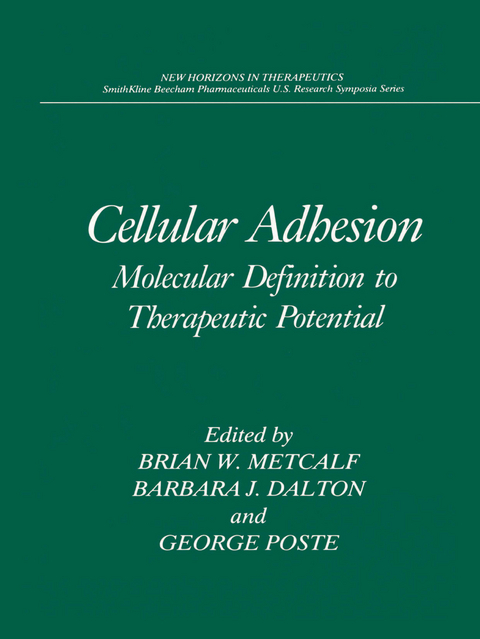
Cellular Adhesion
Springer-Verlag New York Inc.
978-1-4613-6050-6 (ISBN)
Like hormones and cytokines, the sol- uble mediators used by cells for communication, adhesion molecules are defined molecular entities that recognize specific receptor structures on the surface to which they adhere. Recent activity has focused on defining the structure of the individual molecules responsible for many types ofcellularadhesion. New adhe- sion proteins are being cloned with the help of specific antibodies and precise functional assays.
I. Molecular Definition—Adhesion Molecule Structure and Function.- 1 The Biological Function of ?3 Integrins and Other Vitronectin Receptors.- 2 Integrin Modulating Factor and the Regulation of Leukocyte Integrins.- 3 Structure-Function Aspects of Selectin-Carbohydrate Interactions.- 4 Recognition of Cell Surface Carbohydrates by C-Type Animal Lectins.- 5 The Uvomorulin-Catenin Complex: Insights into the Structure and Function of Cadherins.- 6 Cytotactin: A Substrate Adhesion Molecule with Amphitropic Functions in Morphogenesis.- 7 Adhesion Molecules and Bone Remodeling.- II. Biological Consequences of Cellular Adhesion.- 8 Effects of Shear Stress on Leukocyte Adhesion.- 9 Blockade of Leukocyte Adhesion in in Vivo Models of Inflammation.- 10 Proadhesive Cytokine Immobilized on Endothelial Proteoglycan: A New Paradigm for Recruitment of T Cells.- 11 Lung Inflammation and Adhesion Molecules.- 12 Adhesion Molecule-Dependent Cardiovascular Injury.- 13 GPIIb/IIIa Antagonists as Novel Antithrombotic Drugs: Potential Therapeutic Applications.- III. Targeting Adhesion Molecules—Therapeutic Potential.- 14 The Pathological Consequences of Bacterial Adhesion to Medical Devices: A Practical Solution to the Problem of Device-Related Infections.- 15 Peptide Mimetics as Adhesion Molecule Antagonists.- 16 Derivation of Therapeutically Active Humanized and Veneered Anti-CD18 Antibodies.
| Reihe/Serie | New Horizons in Therapeutics |
|---|---|
| Mitarbeit |
Anpassung von: Judy Schatz |
| Zusatzinfo | XXI, 318 p. |
| Verlagsort | New York, NY |
| Sprache | englisch |
| Maße | 210 x 280 mm |
| Themenwelt | Medizin / Pharmazie ► Medizinische Fachgebiete ► Pharmakologie / Pharmakotherapie |
| Medizin / Pharmazie ► Pharmazie | |
| Naturwissenschaften ► Biologie ► Botanik | |
| Naturwissenschaften ► Biologie ► Zoologie | |
| ISBN-10 | 1-4613-6050-1 / 1461360501 |
| ISBN-13 | 978-1-4613-6050-6 / 9781461360506 |
| Zustand | Neuware |
| Haben Sie eine Frage zum Produkt? |
aus dem Bereich


